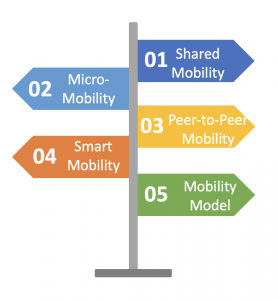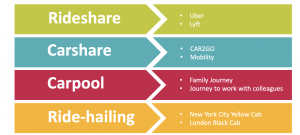There are many terms and phrases used within the mobility concepts. This is particularly true for new forms and models of mobility. When I first started learning about rideshares and carshares, it took me a while to wrap my head around the differences. In this week’s blog, I want to give you an overview of my understanding on some of mobility’s most used terminologies.
The “Mobility” Words
 When everything finishes with “mobility” it can be hard to distinguish the difference between them. Let’s take a closer look.
When everything finishes with “mobility” it can be hard to distinguish the difference between them. Let’s take a closer look.
Shared Mobility
This term sounds new, however the concept of sharing vehicles and thus “shared mobility”, has been around for a long-time. A taxi, a bus or a train, are all forms of shared mobility. What is different today, is that new forms and models of mobility are being introduced and also included under the same term.
Micromobility
I talked about micromobility in my post about commuting at a social distance. Micromobility is the form of mobility that you can have the most fun with, as it includes scooters, skateboards and rollerblades. Basically, these are all the small, lightweight and often slow modes of mobility.
Peer-to-Peer Mobility
This is when a private individual owns and then shares their vehicle with other members of the public. This is also known as Customer-to-Customer (C2C) mobility as it involves no business taking part in providing the transportation.
Smart Mobility
I touched on this topic in my blog about the role mobility plays in the creation of smart cities. This is really just a way of thinking about the future of mobility. Smart mobility brings into consideration all the new forms of shared mobility and has a focus on the positive environmental effect that they can bring.
Mobility Model
This is the business concept behind a particular mobility concept and considers the value capture and creation that a service has. It is often used to talk about the perceived value to the users of the service or product and to understand its possible effects on the system. If you would like to have a closer look at how this looks in reality, then take a look at my blog about the revenue capture models used by some rideshare companies.
Ride sharing, Carsharing, Carpooling and Ride Hailing
These are often used when describing the use of cars within a mobility model. Sometimes they are used accidently as synonyms for one other. But they are actually a little and a lot different. So what’s the difference?
https://www.youtube.com/watch?v=q2sF7jBdgPY
Or to put it a little more simply
 Rideshare
Rideshare
A shared journey with strangers and a driver. Often booked over a C2C platform.
Carshare
The rental of a car in which you drive. Normally, people are a member of a vehicle rental organisation or group and then collect the car at a train station or park house.
Carpooling
The use of a personal vehicle and shared journey with others, most often friends or family (sometimes strangers). This is rarely accessible for strangers, though some platforms exist for this.
Ride Hailing
Sometimes used to refer to the process of booking a taxi via an application. But is really just the use of a taxi ride or Uber ride in which no other passengers are welcome.
Thanks for reading! I hope you have learnt something new.
As I said earlier, this is my understanding of these concepts, if you think I have got something wrong or would like more information on any of the topics covered, then please leave a comment below.




Enjoyed it